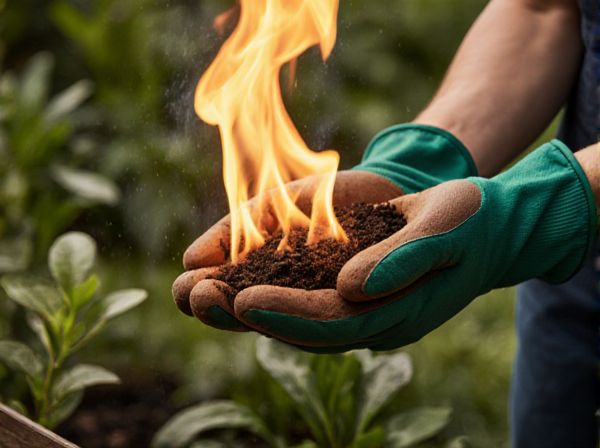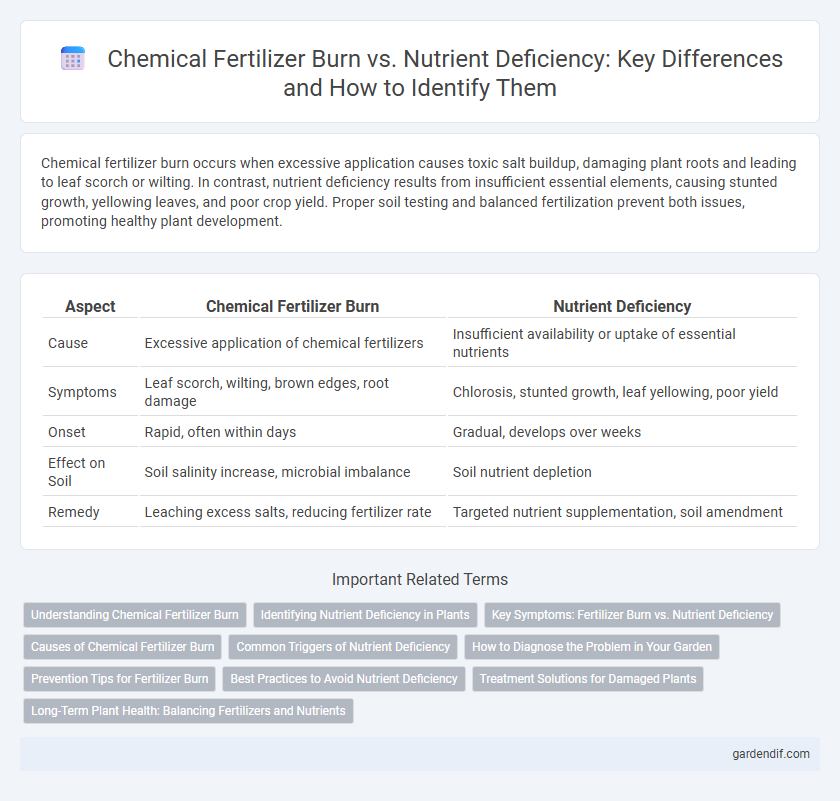
Chemical fertilizer burn vs Nutrient deficiency Illustration
Chemical fertilizer burn occurs when excessive application causes toxic salt buildup, damaging plant roots and leading to leaf scorch or wilting. In contrast, nutrient deficiency results from insufficient essential elements, causing stunted growth, yellowing leaves, and poor crop yield. Proper soil testing and balanced fertilization prevent both issues, promoting healthy plant development.
Table of Comparison
| Aspect | Chemical Fertilizer Burn | Nutrient Deficiency |
|---|---|---|
| Cause | Excessive application of chemical fertilizers | Insufficient availability or uptake of essential nutrients |
| Symptoms | Leaf scorch, wilting, brown edges, root damage | Chlorosis, stunted growth, leaf yellowing, poor yield |
| Onset | Rapid, often within days | Gradual, develops over weeks |
| Effect on Soil | Soil salinity increase, microbial imbalance | Soil nutrient depletion |
| Remedy | Leaching excess salts, reducing fertilizer rate | Targeted nutrient supplementation, soil amendment |
Understanding Chemical Fertilizer Burn
Chemical fertilizer burn occurs when excessive salts in fertilizers draw moisture away from plant roots, causing dehydration and tissue damage. Nutrient deficiency, in contrast, arises from insufficient nutrient availability, leading to stunted growth and discoloration without the scorching symptoms typical of fertilizer burn. Recognizing signs such as leaf tip browning and rapid wilting helps distinguish chemical fertilizer burn from nutrient deficiencies.
Identifying Nutrient Deficiency in Plants
Chemical fertilizer burn often presents as leaf edges turning brown and crispy, while nutrient deficiency typically shows as uniform discoloration or stunted growth. Identifying nutrient deficiency involves observing specific symptoms such as yellowing leaves for nitrogen shortage or purple hues indicating phosphorus lack. Soil testing and tissue analysis can confirm deficiencies, enabling targeted nutrient application to restore plant health.
Key Symptoms: Fertilizer Burn vs. Nutrient Deficiency
Chemical fertilizer burn manifests through leaf scorch, browning edges, and stunted growth due to salt accumulation, while nutrient deficiency shows chlorosis, yellowing between veins, and overall poor plant vigor. Fertilizer burn symptoms often appear rapidly after application, contrasting with the gradual onset of nutrient deficiency signs. Identifying these key differences ensures accurate diagnosis and appropriate plant care interventions.
Causes of Chemical Fertilizer Burn
Chemical fertilizer burn occurs primarily due to the excessive concentration of salts and nutrients near plant roots, leading to osmotic stress that dehydrates plant cells. High levels of nitrogen, potassium, or phosphorus disrupt water absorption, causing leaf scorch, root damage, and inhibited growth. Improper application methods, such as over-fertilizing or applying fertilizer on dry soil, exacerbate the risk of chemical fertilizer burn.
Common Triggers of Nutrient Deficiency
Chemical fertilizer burn occurs when excessive application leads to high salt concentrations in the soil, damaging plant roots and inhibiting nutrient uptake. Common triggers of nutrient deficiency include imbalanced fertilizer use, poor soil pH, and inadequate organic matter, which reduce nutrient availability and absorption efficiency. Understanding these factors aids in optimizing fertilizer application to prevent burn and ensure balanced plant nutrition.
How to Diagnose the Problem in Your Garden
To diagnose whether plants in your garden are suffering from chemical fertilizer burn or nutrient deficiency, closely examine leaf symptoms and soil conditions. Fertilizer burn typically causes leaf edges to turn brown and crispy due to excess salts, while nutrient deficiency often results in specific discoloration patterns such as yellowing or purpling of leaves. Conducting a soil test can confirm salt concentration and nutrient levels, enabling targeted corrective actions.
Prevention Tips for Fertilizer Burn
Fertilizer burn occurs when excessive application of chemical fertilizers leads to high salt concentration in soil, causing root damage and plant stress, while nutrient deficiency results from insufficient essential elements. To prevent fertilizer burn, apply fertilizers according to soil test recommendations, use slow-release formulations, and maintain proper irrigation to dilute salts. Regular monitoring of plant health and adjusting fertilizer rates based on growth stages also helps mitigate risks associated with over-fertilization.
Best Practices to Avoid Nutrient Deficiency
Applying chemical fertilizers in balanced proportions prevents nutrient deficiencies by ensuring optimal nutrient availability while avoiding fertilizer burn, which can damage plant roots and reduce nutrient uptake. Regular soil testing guides precise fertilizer application tailored to specific crop needs, reducing the risk of over-fertilization and promoting healthy plant growth. Incorporating organic matter and following recommended irrigation practices enhances nutrient absorption and mitigates the negative effects of chemical fertilizer misuse.
Treatment Solutions for Damaged Plants
Chemical fertilizer burn causes leaf scorch and root damage, requiring immediate flushing with water to dilute excess salts and prevent further harm. Nutrient deficiency symptoms vary but respond to targeted supplementation using balanced fertilizers or soil amendments tailored to specific lacking nutrients. Restoring plant health involves careful monitoring of soil pH and nutrient levels to optimize absorption and promote recovery.
Long-Term Plant Health: Balancing Fertilizers and Nutrients
Excessive use of chemical fertilizers can cause fertilizer burn, damaging plant roots by creating salt imbalances that inhibit water uptake and stunt growth. Nutrient deficiency, however, deprives plants of essential minerals like nitrogen, phosphorus, and potassium, leading to poor development and reduced yield. Balancing appropriate fertilizer application with soil nutrient monitoring is critical for sustaining long-term plant health and optimizing crop productivity.
Chemical fertilizer burn vs Nutrient deficiency Infographic

 gardendif.com
gardendif.com